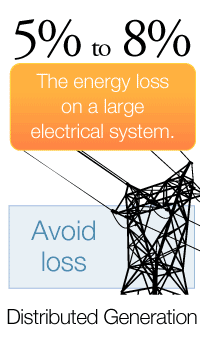City Projects in Energy Efficiency and Conservation
Renewable Energy

Renewable Energy often delivers power through decentralized on-site generators such as solar panels. This on-site generation is often called "distributed generation." While large coal, hydro and nuclear power plants offer economies of scale, they are typically located away from cities to prevent pollution and maximize safety. Thus, cities receiving power from such plants suffer efficiency losses in transmission over long distances. Distributed generation avoids these losses. Cities can take advantage of several types of distributed generation, including cogeneration, photovoltaic systems and plug-in hybrids that feed the grid at peak hours for peak time management.
For more on transmission losses,
click here.
Examples
- Berkeley Unveils Financing Plan That Pays Upfront Cost of Solar and Efficiency Improvements
(e-Newswire, 10/31/07) - Google Feeds the Grid with Plug-in Hybrids
- San Francisco Municipal Solar Installations
- Palm Springs Uses Cogeneration, Saves $906,000 Over 20 Years
- PG&E Cogeneration Contracts
- Cogeneration Coalition
Read our Local Governments Best Practices Guide for ideas on distributed generation.


